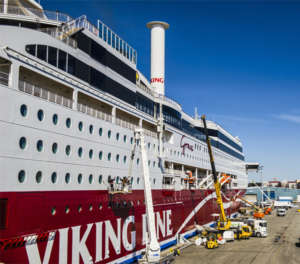Significant reduction of emissions with a Finnish invention – rotor sail would be suited to one third of all large vessels
In mid-April, M/S Viking Grace became the first passenger vessel in the world that gets part of its thrust from a mechanical rotor sail. Cleantech company Norsepower believes in the international potential of its product.

The sun shines in the cloudless sky and the weather is calm in the Port of Turku on the deck of M/S Viking Grace that is under repairs. An unusual maintenance process is in progress.
The experts of Finnish cleantech company Norsepower have spent three days on the ship. During that time, Viking Grace has received a mechanical rotor sail on its deck as the first passenger vessels in the world.
Tuomas Riski, CEO of Norsepower, says that with one rotor sail the vessel can save annually up to 300 tonnes of fuel on the Turku–Stockholm route, which would mean a reduction of 900 tonnes in carbon dioxide emissions per year.

The estimates prepared for Viking Grace are based, for instance, on the data that Norsepower gathered from its first rotor sail customer, shipping company Bore’s cargo vessel Estraden. A rotor sail was installed on Estraden’s deck in the Port of Turku already back in 2014.
”There are wind statistics available for the route between Turku and Stockholm from a long time, which also helps in making an accurate estimate. With several rotor sails, a vessel like Viking Grace could cut its fuel consumption by as much as 5–10 per cent”, Tuomas Riski says.
Time is ripe for commercialising a 90-year-old invention
The operating principle and technology of the rotor sail have been known since the 1920s. The father of the innovation, German Anton Flettner, crossed the Atlantic by using wind energy and rotors already in 1926.
For a long time, the mechanical sail remained a technical curiosity, and no financially feasible application was found. In the 2000s, the increase in fuel prices and the tightening environmental legislation in seafaring paved the way for the second coming of sail ships.
Norsepower is the first player in the world that has managed to develop the rotor sail into a product to be manufactured in large scale. The rotor sail had to be light, efficient and reliable enough.
”The manufacture of a commercial sail was made easier e.g. by the development of composite materials. At present, the payback period of a rotor sail for a customer is around 3–8 years. We believe that we can make it even shorter when the volumes grow”, Tuomas Riski explains.
Compatible technology with 20,000 large vessels
The rotor sail is also a logical ecological update for Viking Grace, which was upon completion the first passenger vessel that uses completely sulphur-free liquefied natural gas (LNG) as fuel.

Viking Line’s new vessel, due for completion in 2020, will be fitted with two mechanical sails. Norsepower has also started co-operation with the giant shipping company Maersk whose tanker will get two 30-metre rotor sails on its deck.
Tuomas Riski sees great potential for his company’s product in cargo vessels and tankers that have room for several rotor sails on their deck.
If the technology becomes common, it could have an enormous effect on reducing the emissions of passenger traffic. Technology that may have a major impact on future seafaring is now being introduces in the Baltic Sea, and regarding passenger traffic on the Turku–Stockholm route in particular.
”There are some 60,000 large vessels sailing on the seas of the world. Our technology is currently suited to around 20,000 of them. More common use of rotor sails would generate significant reductions of emission for the entire global fleet.”’
Watch video about rotor sail installation on Port of Turku’s YouTube-channel >>
Text Jakko Mikkola
Photos Lennart Holmberg
This is how the rotor sail works
- The rotor sail installed on the deck of M/S Viking Grace is 24 metres high and four metres wide.
- When the rotor sail rotates in wind, a pressure difference is generated between the opposite sides of the cylinder made of composite, thus creating thrust.
- The phenomenon is called the Magnus effect. It can also be observed in curve hits and kicks in ball games.
- In strong wind, the cylinder may rotate up to 225 revolutions per minute, or almost four revolutions per second.
- One rotor sail on a vessel the size of Viking Grace on the Turku–Stockholm route can achieve annual fuel savings of around 300 tonnes.
